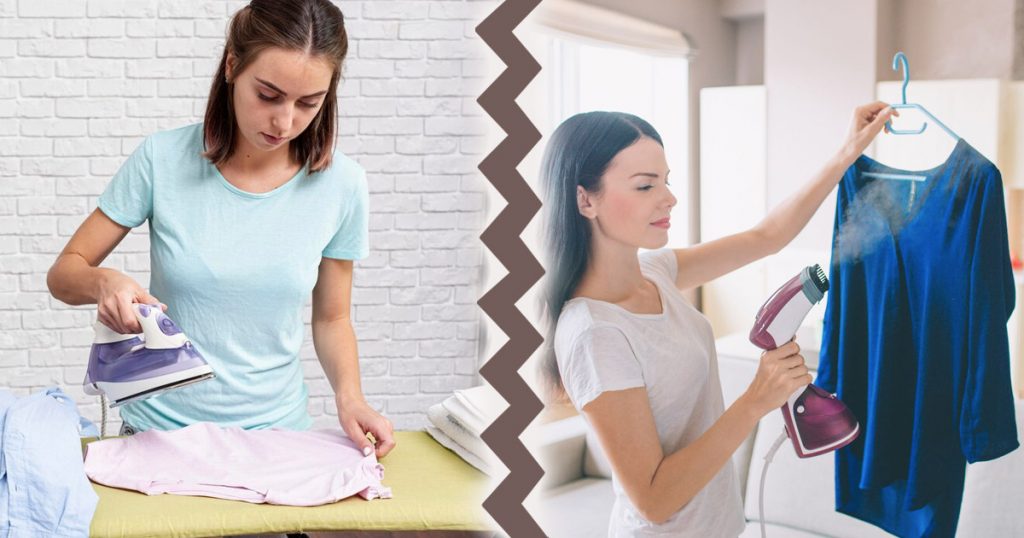Wrinkled clothes can leave you looking less polished, even if everything else is on point. However, ironing—which was once a household essential—is becoming less common. According to a survey, one in three under-35s admits they don’t own an iron, compared to 90% of those over 45 who not only own one but use it regularly. The shift in attitude could be due to relaxed dress codes and work-from-home lifestyles. Whether you find ironing a chore or are considering modern alternatives like steamers, understanding the difference between the two can help you care for your clothes better.
How Do Steamers and Irons Work?
Steamers and irons both fight wrinkles using heat, but they work differently. Steamers release hot vapor that loosens fabric fibers and smooths out creases without direct pressure. They’re especially gentle on delicate items and best used when clothing is hanging vertically. Steam also freshens garments, making it great for clothes that don’t need washing.
Irons, on the other hand, use a heated metal plate to press wrinkles flat. Heat and pressure combine to create crisp results, which makes irons perfect for structured fabrics and sharp creases. If you’re wondering if a steamer works as well as an iron, it depends on the look you’re going for. Steamers may fall short for crisp finishes, but they’re unbeatable for convenience and delicate fabrics.
Fabrics That Are Best for Steaming
Steamers work wonders on lighter, more sensitive fabrics. Here are a few materials where steaming is the best choice:
1. Silk and Satin
The gentle steam removes wrinkles while keeping the material shiny and smooth.
2. Chiffon
Fragile and sheer fabrics like chiffon wrinkle easily but respond well to steam.
3. Wool and Wool Blends
Perfect for sweaters or coats, steam helps refresh wool without shrinkage.
4. Velvet
Steaming maintains the soft nap of velvet, keeping it plush and wrinkle-free.
5. Lace or Embellished Fabrics
Steam works well for beaded or sequined clothes, avoiding damage to details.
6. Upholstery and Drapes
Steam large and heavy items like curtains or furniture covers without needing to take them down.
Steaming isn’t just about de-wrinkling. It also helps kill bacteria and remove odors, making it ideal for freshening clothes between washes. However, steamers can struggle with heavy, stiff materials.
Fabrics That Are Better for Ironing
For structured garments and durable fabrics, ironing is the way to go. These items benefit the most from direct pressure and heat:
1. Cotton
From casual T-shirts to crisp button-downs, cotton looks sharp after ironing.
2. Linen
Known for its wrinkles, linen smooths out beautifully under a high heat iron.
3. Denim
Stubborn creases in jeans or jackets are no match for the hot plate of an iron.
4. Canvas and Twill
Stiff fabrics like these love the combination of heat and pressure.
5. Dress Shirts and Trousers
For formal wear, ironing provides the sharp lines and creases needed for a professional look.
While irons provide precision, they can scorch delicate fabrics if the temperature is too high. Always check clothing labels to match the heat setting to the material.
Is a Steamer Better Than an Iron?
Many people ask, Is a steamer the same as an iron? Not quite! Each tool has its strengths. Steamers are better suited for delicate fabrics, quick fixes, and travel. They work faster than irons and are easier to use without a complex setup. For instance, hanging clothes can make steaming easier, eliminating the need for an ironing board.
Irons, on the other hand, hold their ground for heavier fabrics and those needing structure or sharpness. If you’re preparing a business suit or pleated skirt for an office meeting, there’s no substitute for an iron’s results.
How to Use Each Method Safely and Effectively
Steaming Tips
- Use distilled water to prevent mineral buildup.
- Hang your garment and steam it while moving the nozzle up and down slowly.
- Keep the steamer about 1–2 inches from the fabric to avoid water spots.
- Allow clothes to dry completely before wearing to prevent new wrinkles from forming.
Ironing Tips
- Sort clothes by fabric type and adjust the iron’s heat setting accordingly.
- Mist garments lightly with water for better wrinkle removal.
- Iron on the reverse side of delicate or printed fabrics to avoid marks.
- Keep the iron moving to prevent scorching, and always use a pressing cloth if unsure.
Wrinkle-Free Wardrobe, Your Way!
The iron vs. steamer dilemma doesn’t have to be a difficult choice. They’re different tools for different tasks. For delicate fabrics, flowing materials, or quick touchups, a steamer is your best bet. For structured garments, heavy-duty fabrics, and polished finishes, an iron will never fail you.
Whether you’re steaming for convenience or ironing for precision, using these tools properly will save your clothes from wear and help you look your best. Next time you ask, “Can a steamer replace an iron?” or “Is it better to iron or steam clothes?” Remember, both tools can serve you well. It’s all about picking the right one for the task at hand!
